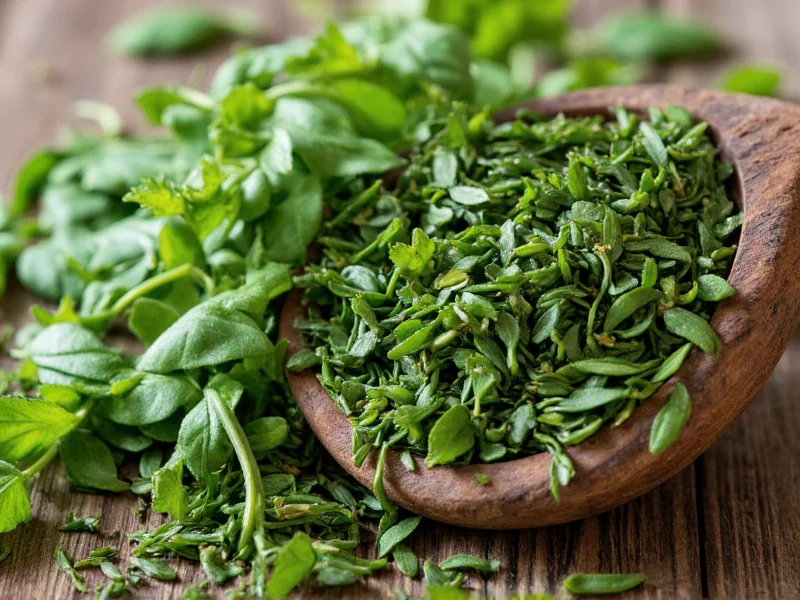Understanding Mixed Herbs: A Culinary Essential
When exploring what are mixed herbs in cooking, it's important to recognize they serve as versatile flavor foundations across global cuisines. Unlike single herb varieties, mixed herbs offer complex flavor profiles that enhance soups, stews, roasted meats, and vegetable dishes with minimal effort.
Common Components of Mixed Herbs Blends
The composition of mixed herbs varies significantly depending on regional preferences and intended culinary applications. Most commercial blends contain between three to six different herbs carefully selected for complementary flavors.
| Common Herb | Flavor Profile | Primary Culinary Uses |
|---|---|---|
| Parsley | Fresh, slightly peppery | Finishing dishes, sauces, salads |
| Basil | Sweet, slightly minty | Italian cuisine, tomato-based dishes |
| Oregano | Earthy, slightly bitter | Mediterranean dishes, pizza, pasta sauces |
| Thyme | Subtle lemon-pine flavor | Roasted meats, stews, braises |
| Rosemary | Pine-like, robust | Lamb, potatoes, breads |
| Sage | Earthy, slightly peppery | Poultry, stuffing, butter sauces |
Regional Variations in Mixed Herbs
Understanding what are mixed herbs across different culinary traditions reveals fascinating regional distinctions. What works as a standard blend in one country might be completely different elsewhere.
Mediterranean Mixed Herbs: Typically feature oregano, basil, rosemary, and thyme. These blends work exceptionally well with tomato-based sauces, grilled vegetables, and seafood dishes. The best mixed herbs for Italian cuisine usually emphasize basil and oregano as primary components.
French Herbes de Provence: A specific type of mixed herbs blend containing lavender, thyme, rosemary, oregano, and marjoram. This distinctive combination creates the characteristic flavor of southern French cuisine.
American Mixed Herbs: Often simpler blends focusing on parsley, thyme, and rosemary. These work well with roasted meats and traditional American comfort foods.
Practical Applications in Cooking
Knowing how to use mixed herbs in recipes properly can transform ordinary dishes into culinary delights. The timing of when you add mixed herbs significantly impacts flavor development.
Dried mixed herbs benefit from being added early in the cooking process to allow their flavors to infuse throughout the dish. For most soups, stews, and braises, add dried mixed herbs during the first 15-20 minutes of cooking. Fresh mixed herbs work best when added in the final stages of cooking or used as a garnish to preserve their delicate flavors.
When following recipes that call for mixed herbs, consider the specific blend you're using. If your blend contains stronger herbs like rosemary or sage, use slightly less than the recipe specifies to avoid overpowering the dish.
Fresh vs. Dried Mixed Herbs: What You Need to Know
Understanding the difference between fresh and dried mixed herbs is crucial for successful cooking. Each form offers distinct advantages depending on your culinary needs.
Dried mixed herbs have more concentrated flavors and longer shelf lives, making them convenient pantry staples. They work particularly well in long-cooking dishes where their flavors can fully develop. When substituting dried for fresh mixed herbs in cooking, use one-third the amount since dried herbs are more potent.
Fresh mixed herbs provide brighter, more delicate flavors ideal for finishing dishes or using in cold preparations. They're perfect for salad dressings, compound butters, or as garnishes. For immediate flavor impact in quick-cooking dishes, fresh mixed herbs outperform their dried counterparts.
Creating Your Own Mixed Herbs Blend
While commercial mixed herbs offer convenience, making your own blend allows for customization based on personal taste preferences and specific recipe requirements. A homemade mixed herbs recipe gives you complete control over quality and proportions.
Basic Homemade Mixed Herbs Recipe:
- 2 parts dried parsley
- 1 part dried basil
- 1 part dried oregano
- 1 part dried thyme
- ½ part dried rosemary (finely crushed)
- ½ part dried sage (optional)
Mix thoroughly and store in an airtight container away from light and heat. This versatile blend works well for most Mediterranean-inspired dishes. For Italian-specific applications, increase the basil and oregano proportions. For heartier meats, add more rosemary and thyme.
Storage and Shelf Life Considerations
Proper storage significantly impacts the quality and longevity of your mixed herbs. Dried mixed herbs maintain optimal flavor for 6-12 months when stored correctly in airtight containers away from light, heat, and moisture.
Fresh mixed herbs require different handling. Store them like cut flowers—trim the stems and place in a small container of water, then cover loosely with a plastic bag in the refrigerator. Use fresh mixed herbs within 5-7 days for best flavor.
To test if your dried mixed herbs have lost potency, rub a small amount between your fingers and smell. If the aroma is weak or barely noticeable, it's time to replace them. Properly stored mixed herbs should retain vibrant color and strong fragrance.
Substituting Mixed Herbs in Recipes
When you don't have mixed herbs on hand, understanding suitable substitutes prevents recipe failures. The best substitute depends on which specific herbs your blend would have contained.
If your recipe calls for mixed herbs and you need a substitute for mixed herbs in cooking, consider these options:
- For Mediterranean dishes: Equal parts oregano and basil
- For French cuisine: Thyme and tarragon
- For general purpose: Double the amount of your primary herb plus a pinch of complementary herbs
When substituting individual herbs for mixed herbs, remember that the blend's complexity comes from multiple flavor notes. Using just one herb will create a different flavor profile, so adjust quantities accordingly.











 浙公网安备
33010002000092号
浙公网安备
33010002000092号 浙B2-20120091-4
浙B2-20120091-4